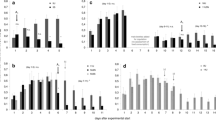Abstract
Tests on the efficiency of methyl bromide especially at lower temperatures in controlling Khapra Beetle Larvae (Trogoderma granarium Everts), Dermestidae, Coleoptera
In the laboratory, experiments were carried out to investigate the efficiency of methyl bromide in controlling the Khapra Beetle (Trogoderma granarium Everts) in a specially developed fumigation apparatus at 30, 25, 20, 15, 10, 5, 0, −6, and −10 °C as well as 40 – 70% relative humidity. The lethal dosis as c. t. products in mg.h/l were estimated at different temperatures from the dosis-mortality regression lines. The treated larvae were divided after the fumigation into two series (1 and 2). The larvae of serie 1 were held immediately after the fumigation time at 28°C, while the larvae of serie 2 were kept for another 10 days at the same fumigation temperature, then removed to 28°C until final control. Experimental results of both series showed that, for a given mortality the c. t. product required at low temperatures considerably increased and accordingly the tolerance of the larvae decreased with a rise in temperature (in range 0–30°C). A maximum in the tolerance of the larvae to methyl bromide was found at 0°C. At lower trial temperatures −6 and −10°C the required c. t. product subsequently decreased. This result was caused through the combined harmful effect of the low temperatures and the methyl bromide. It is evident from the estimated values that the c. t. products of methyl bromide required for a given mortality in serie 2 especially at lower temperatures (from +10 to −10°C) are lower than that in serie 1. For example in serie 2 the c. t. product required to kill the larvae decreased at 5°C to less than 50%. This effect of the post-treatment temperature was also examined to obtain the shortest holding time for maximum mortality, which was observed after 3–4, 7–8, 7–8 and 8–9 days at 10, 5, 0, and −6°C respectively. From a practical aspect this result is of great importance, because it proves the influence of the factors prevailing after a quarantine fumigation.
Similar content being viewed by others
Literaturverzeichnis
Bond, E. J., 1975: Fumigation of insects at low temperatures. J. econ. Ent.68, (4), 539–542.
Burges, H. D., 1959: Studies on the dermestid beetleTrogoderma granarium Everts II. The occurence of diapause larvae at a constant temperature, and their behaviour. Bull. ent. Res.50, (2), 407–422.
Busvine, J. R., 1971: A critical review of the techniques for testing insecticides. Commonwealth Institute of Entomology, London, 345 S.
Cotton, R. T., 1932: The relation of respiratory metabolism of insects to their susceptibility to fumigants. J. econ. Ent.25, (5), 1089–1103.
Freeman, J. A., 1973: Infestation and control of pests of stored grain in international trade. Chapter 5, Pages 99–136 in R. N. Sinha, and W. E. Muir, eds. Grain storage-part of a system. Avi Publ. Co., Westport, Conn. 481 S.
Heseltine, H. K., 1961: The use of thermal conductivity meters in fumigation research and control. Pest Infest. Res. Bull. No. 2, 1–12.
Heseltine, H. K.;Thompson, R. H., 1973: Fumigation with methyl bromide under gas proof sheets. Ministry of Agriculture, Fisheries and Food, London, 58 S.
Hinds, W. E.;Turner, W. E., 1910: Carbon disulphide for the rice-weevil in corn. J. econ. Ent.3 47–57.
Jones, E. W., 1933: The influence of temperature on toxicity of carbon disulphide to wireworms. J. econ. Ent.26, 887–892.
Lindgren, D. L., 1935: The respiration of insects in relation to the heating and fumigation of grain. Techn. Bull. Univ. Minn. agric. Exp. Sta., No. 109, 32 S.
Lindgren, D. L.;Lloyd, E. V.;Krohne, H. E., 1955: The khapra beetle,Trogoderma granarium Everts. Hilgardia24, (1), 1–36.
Lindgren, D. L.;Vincent, L. E., 1960: Response of quiescient khapra beetle larvae to fumigation and to low temperatures. J. econ. Ent.53, (4), 698–699.
Muthu, M.;Pingale, S. V., 1956: Extent of variation caused by certain factors in the toxicity of ethylene dichloride - CCl4 mixture to insects. Indian J. Ent.17, 193–200.
Punj, G. K.;Girish, G. K., 1969: Relative toxicity of certain fumigants toTrogoderma granarium Everts (Coleoptera, Dermestidae). J. stored Prod. Res.4, 339–342.
Shephard, H. H.;Lindgren, D. L.;Thomas, E. L., 1937: The relative toxity of insect fumigants. Techn. Bull. Univ. Minn. agric. Exp. Sta.120, 1–23.
Sun, Y. P., 1947: Analysis of some important factors affecting the results of fumigation tests. Tech. Bull. Univ. Minn. agric. Exp. Sta., No. 177, 104 S.
Voelkel, H., 1924: Zur Biologie und Bekämpfung des Khaprakäfers,Trogoderma granarium Everts. Sonderdruck aus den Arbeiten der Biologischen Reichsanstalt für Land- u. Forstwirtschaft, Berlin-Dahlem,13, (2), 171 S.
Wohlgemuth, R., 1971: Methoden zur Konzentrationsmessung von Methylbromid im Vorratsschutz. Mitteilungen aus der Biologischen Bundesanstalt für Land u. Forstwirtschaft, Berlin-Dahlem,142, 33 S.
Author information
Authors and Affiliations
Rights and permissions
About this article
Cite this article
El-Lakwah, F. Untersuchungen zur Wirkung von Methylbromid besonders bei niedrigen Temperaturen gegen Khaprakäfer-Larven (Trogoderma granarium Everts (Dermestidae, Coleoptera). Anz. Schadlingskde., Pflanzenschutz, Umweltschutz 50, 68–73 (1977). https://doi.org/10.1007/BF02179526
Issue Date:
DOI: https://doi.org/10.1007/BF02179526




